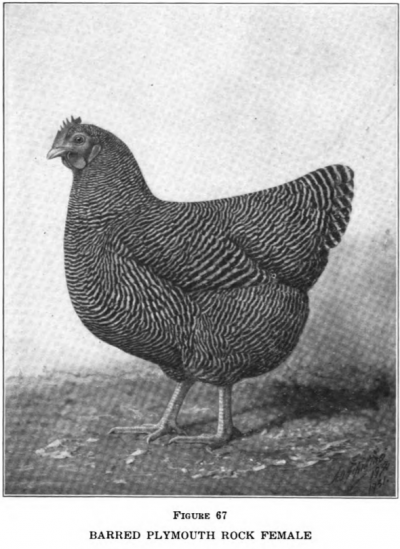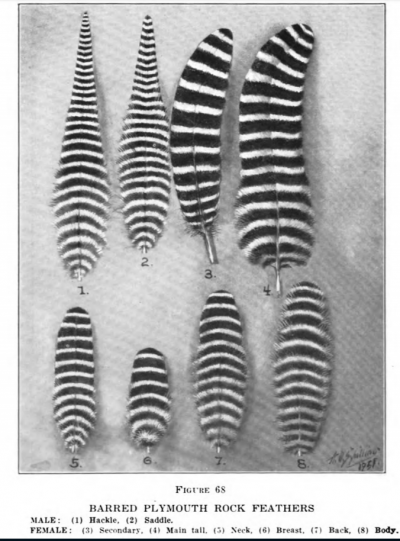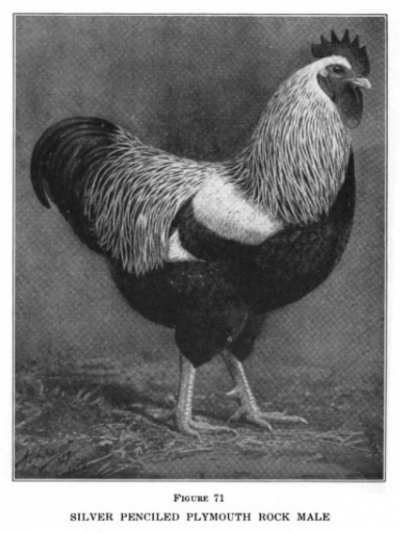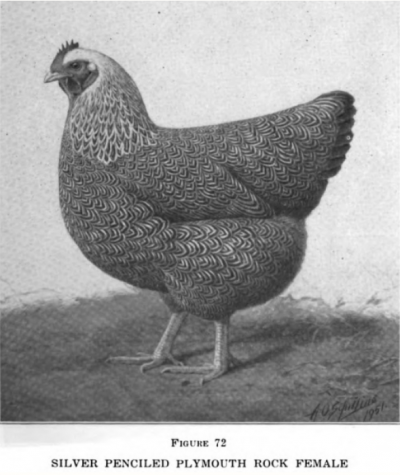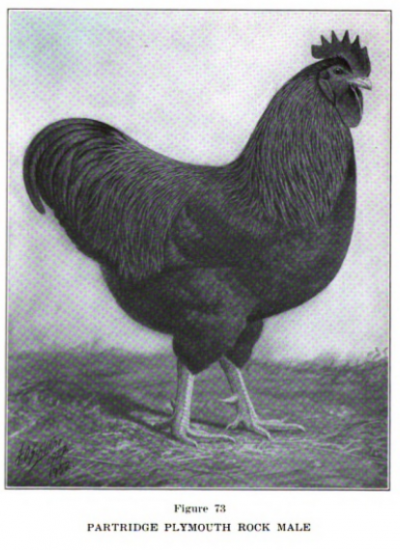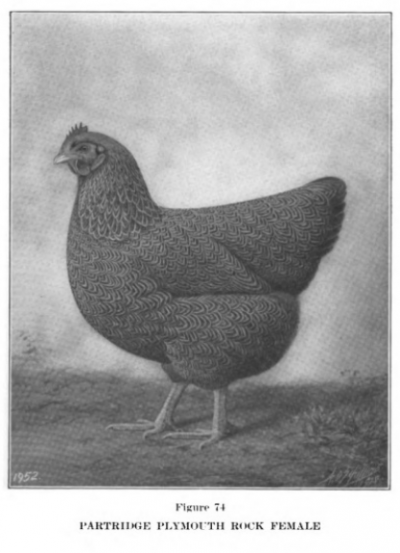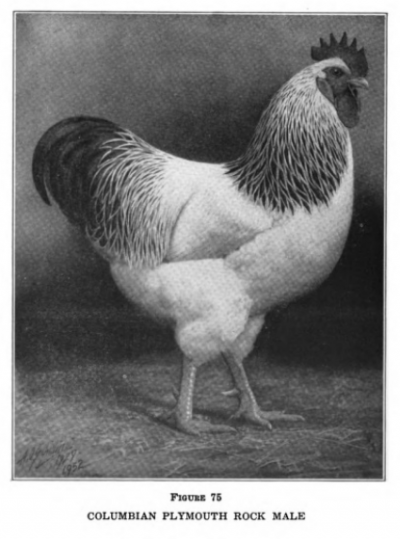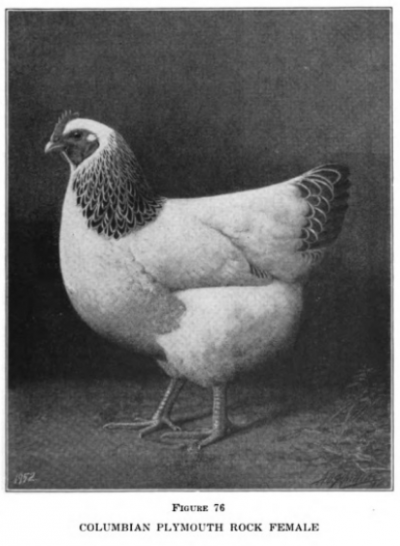Plymouth Rock
| Plymouth Rock | |||
|---|---|---|---|
| Origin | Category | Egg Colour | Sitter |
| America | Softfeather Heavy | Tinted | Yes |
The Plymouth Rock was developed in America in the middle of the 19th century and was first exhibited as a breed in 1869. Several individuals claimed its invention, using crosses of Dominique, Java, Cochin, and Brahma. The first Plymouth Rock was barred and other varieties developed later. The Breed quickly became popular due to its qualities as an outstanding farm chicken: hardiness, docility, broodiness, and excellent production of both eggs and meat. Originally the name Plymouth Rock implied a barred bird, but as more varieties were developed, it became the designation for the breed. The Barred Plymouth Rock was one of the foundation breeds for the broiler industry in the 1920's.
In Australia the Plymouth Rock is usually seen in the Dark Barred variety. Light Barred and other colour varieties are rare.
GENERAL CHARACTERISTICS
SHAPE OF MALE
Head: Moderately large, broad, medium in length.
Beak: Stout, comparatively short, regularly curved.
Eyes: Full, prominent.
Comb: Single, ralher small in proportion to size of specimen, set firmly on the head, straight and upright, evenly serrated, having five welldefined points, those in front and at rear a trifle smaller than the other three, giving the comb a semi-oval appearance when viewed from the side; fine in texture; blade not conforming too closely to head.
Wattles and Ear-Lobes : Wattles, moderately long, free from serrations, nicely rounded at the lower edges, equal in length, fine in texture, free from folds or wrinkles. Ear-lobes, oblong, smooth, hanging about half the length of wattles.
Neck: Rather long, slightly arched, having abundant hackle flowing well over shoulders.
Wings: Of medium size, well folded; wing-fronts well covered by the breast feathers and wing-points well covered by the saddle feathers. Back: Bather long, broad its entire length, flat at shoulders, nearly horizontal from neck to saddle, where there is a slight concave sweep to tail; saddle feathers, rather long, abundant, filling well in front of tail.
Tail: Of medium length, moderately well spread, carried at an angle of forty-five degrees from the horizontal, forming no apparent angle with the back; sickles, well curved, covering tops of main tail feathers, conforming to the general shape of the tail; lesser sickles and tail-coverts of medium length, nicely curved and sufficiently abundant to almost hide the stiff feathers of the tail when viewed from front or side.
Breast: Broad, moderately deep, well rounded.
Body and Fluff: Body, rather long, broad, deep, full; keel-bone, rather long, straight, extending well forward, connecting with breast so as to make no break in outline. Fluff, moderately full.
Legs and Toes: Thighs, large, of medium length, well covered with soft feathers. Shanks, of medium length, smooth, straight, stout, set well apart. Toes, straight, of medium length, well spread. Shanks and toes free from feathers, stubs or down.
SHAPE OF FEMALE
Head: Moderately large, broad, medium in length.
Beak: Comparatively short, regularly curved.
Eyes: Full, prominent.
Comb: Single, small, proportional to the size of the specimen, set firmly on the head, straight and upright, evenly serrated, having five welldefined points, those in front and at rear being somewhat smaller and shorter than the other three.
"Wattles and Ear-Lobes: Wattles, small, well rounded, equal in length, line in texture. Ear-lobes, oblong in shape, smooth.
Neck: Medium in length, nicely curved and tapering lo head, where it is comparatively small; hackle, moderately full, flowing well over the shoulders with no apparent break at juncture of neck and back. Wings: Of medium size, well folded; wing-fronts, well covered by the breast feathers.
Back: Rather long, broad its entire length, flat at shoulders, rising with a slightly concave incline to tail.
Tail: Of medium length, fairly well spread, carried at an angle of thirty-five degrees from the horizontal, forming no apparent angle with the back; tail-coverts, well developed.
Breast: Broad, moderately deep, well rounded.
Body and Fluff: Body, rather long, moderately deep, full; keelbone, rather long, straight from front to rear and extending well forward, connected with the breast so as to make no break in outline. Fluff, full, of medium length.
Legs and Toes: Thighs, of medium size and length, well covered with soft feathers. Shanks, of medium length, set well apart, stout and smooth. Toes, of medium size and length, straight, well spread. Shanks and toes free from feathers, stubs or down.
COLOR OF MALE AND FEMALE
BARRED ROCKS
Beak: Yellow.
Eyes: Reddish-bay.
Comb, Face, Wattles and Eak-Lobes: Bright red.
Shanks and Toes: Yellow; red showing at outside of shanks back of scales, not a defect in males.
Plumage: Grayish-white, each feather crossed by regular, narrow, parallel, sharply-defined, dark bars that stop short of positive black; free from shafting, brownish tinge or metallic sheen; the light and dark bars to be of equal width and to extend throughout the length of the feathers in all sections of the fowl, the barring continuing through the shaft of the feather and into the fluff and the undercolour, and each feather ending with a narrow, dark tip, the combination of overlapping feathers giving the plumage a bluish appearance.
WHITE PLYMOUTH ROCKS
Disqualifications
Positive white in ear-lobes; red, buff or positive black in any part of plumage; shanks other than yellow.(See general disqualifications.)
COLOR OF MALE AND FEMALE
Beak: Yellow.
Eyes: Reddish-bay.
Comb, Face, Wattles and Ear-Lobes: Bright red.
Shanks and Toes: Rich yellow; red showing at outside of shanks back of scales, not a defect in males.
Plumage: Web, fluff and quills of feathers, in all sections, pure white.
BLACK PLYMOUTH ROCKS
COLOR OF MALE AND FEMALE
Beak: Yellow.
Eyes: Reddish-bay.
Comb, Face, Wattles and Ear-Lobes: Bright red.
Shanks and Toes: Rich yellow; red showing at outside of shanks back of scales, not a defect in males.
Plumage: Black with a beetle green sheen.
BUFF PLYMOUTH ROCKS
Disqualifications
Positive white in ear-lobes; shanks other than yellow. (See general disqualifications.)
COLOR OF MALE
Beak: Rich yellow.
Eyes: Reddish-bay.
Comb, Face, Wattles and Ear-Lobes: Bright red.
Shanks and Toes: Rich yellow; red showing at outside of shanks, back of scales, not a defect.
Plumage: Surface throughout an even shade of rich, golden buff, free from shafting or mealy appearance, the head, neck, hackle, back, wing-bows and saddle richly glossed; under-color, a lighter shade, free from foreign color. Different shades of buff in two or more sections is a serious defect. A harmonious blending of buff in all sections is most desirable.
COLOR OF FEMALE
Beak: Rich yellow.
Eyes: Reddish-bay.
Comb, Face. Wattles and Ear-Lobes: Bright red.
Shanks and Toes: Rich yellow.
Plumage: Surface throughout an even shade of rich, golden buff, free from shafting or mealy appearance, the head and neck plumage showing a luster of the same shade as the rest of the plumage; undercolor, a lighter shade, free from foreign color. Different shades of buff in two or more sections is a serious defect. A harmonious blending of buff in all sections is most desirable.
SILVER PENCILED PLYMOUTH ROCKS
Disqualifications
Positive white in ear-lobes; shanks and toes other than yellow or dusky yellow.
COLOR OF MALE
Head : Plumage, silvery white.
Beak: Yellow, or dusky yellow.
Eyes: Reddish-bay.
Comb, Face, Wattles axd Ear-Lobes: Bright red.
Neck: Silvery white, with a lustrous, greenish-black stripe extending down each feather, and running nearly parallel with edges of feather, and tapering to a point near its extremity; under-color, slate or bluish white.
Wings: Wing-bows, silvery white; primaries, black, excepting a narrow edging of white on lower edge of lower web; secondaries, black, except lower half of lower web, which should be white, except near end of feathers, at which point the white terminates abruptly leaving the end of the feathers black; wing-coverts, lustrous greenish-black, forming a well-defined bar of this color across wing when folded.
Back: Silvery white, free from brown; saddle, silvery white, with a black stripe in each feather, same as hackle; under-color, slate or bluish white.
Tail: Black; sickles, lustrous greenish-black; coverts, lustrous greenish-black, edged with white.
Breast: Black; under-color, slate or bluish-white.
Body and Fluff: Body, black: under-color, slate or bluish-white.
Fluff, black, slightly tinged with gray.
Legs and Toes: Thighs, black. Shanks and toes, yellow, or dusky yellow; red showing at outer sides of shanks back of scales, not a defect.
COLOR OF FEMALE
Head : Plumage, silvery gray.
Beak: Yellow, or dusky yellow.
Eyes : Reddish-bay.
Comb, Face, Wattles and Ear-Lobes: Bright red.
Neck: Silvery white, with broad black stripe running nearly parallel with edges and extending down middle of each feather, tapering to a point near its extremity and free from white shaft; under-color, slate.
Wings: Primaries, black, with narrow edge of steel-gray penciling on lower web; secondaries, upper web black, lower web gray, with distinct dark penciling extending around outer edge of feather; shoulder and wing coverts, steel-gray, with distinct dark penciling, outlines of which conform to shape of feather; under-color, slate.
Back: Steel-gray, with distinct dark penciling, outlines of which conform to shape of feather; feathers free from white shaft; under-color, slate.
Tail: Black, except the two top feathers which are penciled on upper edge; coverts, gray, with distinct dark penciling, outlines of which conform to shape of feather.
Breast; Steel-gray, with distinct dark penciling, outlines of which conform to shape of feather, the penciling reaching well up on throat; under-color, slate.
Body and Fluff: Body, steel-gray, with distinct dark penciling, outlines of which conform to shape of feather, the penciling reaching well down on thighs. Fluff, steel-gray, tinged with lighter shade; undercolor, slate.
Legs and Toes. Thighs, gray, with distinct penciling. Shanks and toes, yellow or dusky yellow.
Note: Each feather in hock, breast, body and wing-bows to have two or more distinct pencilings.
PARTRIDGE PLYMOUTH ROCKS
Disqualifications
Positive white in ear-lobes; positive white extending into tail feathers of cockerel; shanks other than yellow or dusky yellow. (See general disqualifications.)
COLOR OF MALE
Head: Plumage, bright red.
Beak: Dark horn, shading to yellow at point.
Eyes: Reddish-bay.
Comb, Face, Wattles and Ear-Lobes: Bright red.
Neck: Bright red, with a lustrous greenish-black stripe running nearly parallel with edges and extending through each feather, taperinoto a point near its extremity; under-color, slate.
Wings: Wing-bows, dark red; fronts, black; primaries, black, lower edges of web, reddish-bay; secondaries, black, outside web reddish-bay terminating with greenish-black at end of each feather; coverts, lustrous greenish-black, forming well-defined bar of this color across wing when folded.
Back: Dark red; saddle, bright red, with lustrous greenish-black stripe down the middle of each feather, same as in hackle; under-color, slate.
Tail: Black; sickles and coverts, lustrous greenish-black, edged with bright red.
Breast: Lustrous black; under-color, slate.
Body and Fluff: Body, black. Fluff, black; under-color, slate.
Legs and Toes: Thighs, black, under-color, slate. Shanks and toes, yellow or dusky yellow.
COLOR OF FEMALE
Head: Plumage, mahogany brown.
Beak: Dark horn, shading into yellow at point.
Eyes: Reddish-bay.
Comb, Face, Wattles and Ear-Lobes: Bright red.
Neck- Bright red, with a lustrous black stripe extending down the middle of each feather, running nearly parallel with edge of feather and tapering to a point near its extremity.
Wings: Wing-bows, mahogany brown, penciled with black; primaries, black, with edging of mahogany brown on outer web; secondaries, inner web black, outer web mahogany brown penciled with black, penciling conforming to shape of feather.
Back: Mahogany brown, distinctly penciled with black, the outlines of penciling conforming to shape of feather; under-color, slate.
Tail: Black, the two top feathers black, penciled with mahogany brown on upper edge; coverts, mahogany brown, penciled with black.
Breast: Mahogany brown, distinctly penciled with black, the penciling being of same character as that of back and extending to throat; under-color, slate.
Body and Fluff: Body, mahogany brown, penciled with black. Fluff, mahogany brown; under-color, slate.
Legs and Toes : Thighs, mahogany brown, penciled with black.
Shanks and toes, yellow or dusky yellow.
COLUMBIAN PLYMOUTH ROCKS
Disqualifications
Positive white in ear-lobes; shanks other than yellow. (See general disqualifications.)
COLOR OF MALE
Head: Plumage, white.
Beak: Yellow, with dark stripe down upper mandible.
Eyes: Bay, or reddish-bay.
Comb, Face, Wattles and Ear-Lobes: Bright red.
Neck: Plumage, other than hackle, white; hackle, web white, with solid, lustrous greenish-black stripe extending from fluff down middle of each feather, running nearly parallel with edges of feather and tapering to a point near its extremity. Under-color, white, bluish-white or slate.
Wings: Wing-bows, white, except fronts which may be partly black; primaries, black, with white edging on lower edge of lower web; secondaries, lower portion of lower web white, sufficient to secure a white wingbay, the white extending around ends of feathers and lacing upper portion of upper web, this color growing wider in the shorter secondaries, the five next to the body being white on surface when wing is folded; remainder of each secondary, black.
Back: Surface color, white; cape, black and white; saddle, white, with occasional feathers striped with black; under-color, either white, bluish-white or slate.
Tail: Black, the curling feathers underneath, white, or black and white; sickles and coverts, lustrous greenish-black; lesser coverts, lustrous greenish-black, edged with white.
Breast: Surface and under-color, white; under-color at juncture with body, white, bluish white or slate.
Body and Fluff: Body, white, except under wings where it may be white, bluish-white or slate; under-color, white or bluish-white. Fluff, white; under-color, white or bluish-white.
Legs and Toes: Thighs, surface color, white; under-color, white or bluish-white. Shanks and toes, yellow; red showing at outer sides back of scales not a defect.
COLOR OF FEMALE
Head: Plumage, white.
Beak: Yellow, or yellow with dark stripe down the upper mandible.
Eyes: Bay, or reddish-bay.
Comb, Face, Wattles and Ear-Lobes: Bright red.
Neck : Hackle, beginning at juncture of head with neck, web, white, with a solid, wide, lustrous greenish-black stripe, extending down middle of each feather, running nearly parallel with edges of feather and tapering to a point near its extremity.
Wings: Wing-bows, white; primaries, black, with white edging on lower edge of lower web; secondaries, lower portion of lower web, white, sufficient to secure a white wing-bay, the white extending around the ends and lacing upper portion of upper web, this color growing wider in the shorter secondaries, the five next to the body being white on the surface when wing is folded; remainder of each secondary, black.
Back: Surface, white, occasional black ticking not a serious defect; cape, white, or black and white: under-color, white, bluish-white or slate.
Tail: Black, except the two top feathers which are edged with white; tail-coverts, black, edged with white.
Breast: Surface and under-color, white; under-color, at juncture with body, white or bluish-white.
Body and Fluff: Body, white, except under wings, where it may be white or bluish-white; under-color, white or bluish-white. Fluff, white.
Legs and Toes: Thighs, white; under-color, white or bluish-white.
Shanks and toes, yellow.
STANDARD WEIGHTS
Large Fowl
Cock 9 1/2 lbs (4.3kg). Hen 7 1/2 lbs (3.2kg).
Cockerel 8 lbs (3.2kg). Pullet 6 lbs (2.7kg).
Bantams
The shape, color and disqualifications, except for weight, of Plymouth Rock Bantams shall be the same as for the corresponding variety of Plymouth Rocks.
Cock 36 oz (1kg). Hen 32 oz (907g).
Cockerel 32 oz (907g). Pullet 28 oz (793g).
SCALE OF POINTS
| Scale Points | |
|---|---|
| Type | 25 |
| Colour and barring | 30 |
| Head | 10 |
| Tail | 10 |
| Legs & Feet | 5 |
| Condition | 10 |
| Size | 10 |
| 100 |
SERIOUS DEFECTS
- Positive white in ear-lobes;
- Red in any part of plumage;
- Two or more solid black primaries,
- Secondaries or main tail feathers;
- Shanks other than yellow, with due allowances for fading with age, dark spots not to disqualify.
(See general Disqualifications.)
SOURCES
- Sourced from: The American standard of perfection, illustrated. A complete description of all recognized varieties of fowls by American Poultry Association. Publication date c1910] https://archive.org/details/americanstandard00ameriala/page/16
- Images sourced from The American standard of perfection, illustrated. A complete description of all recognized varieties of fowls as revised by the American Poultry Association, inc., at its seventy-sixth convention in Honesdale, Pennsylvania, 1949; seventy-eight convention in Roanoke, Virginia, 1951; seventy-ninth convention in Fort Worth, Texas, 1952. https://catalog.hathitrust.org/Record/009169010
- The Poultry club standards, containing a complete description of all the recognised varieties of fowls, ducks, geese and turkeys, ed. by William W. Broomhead. https://catalog.hathitrust.org/Record/009202629
- Department of Animal Science Oklahoma State University: http://afs.okstate.edu/breeds/poultry/chickens/plymouthrock

